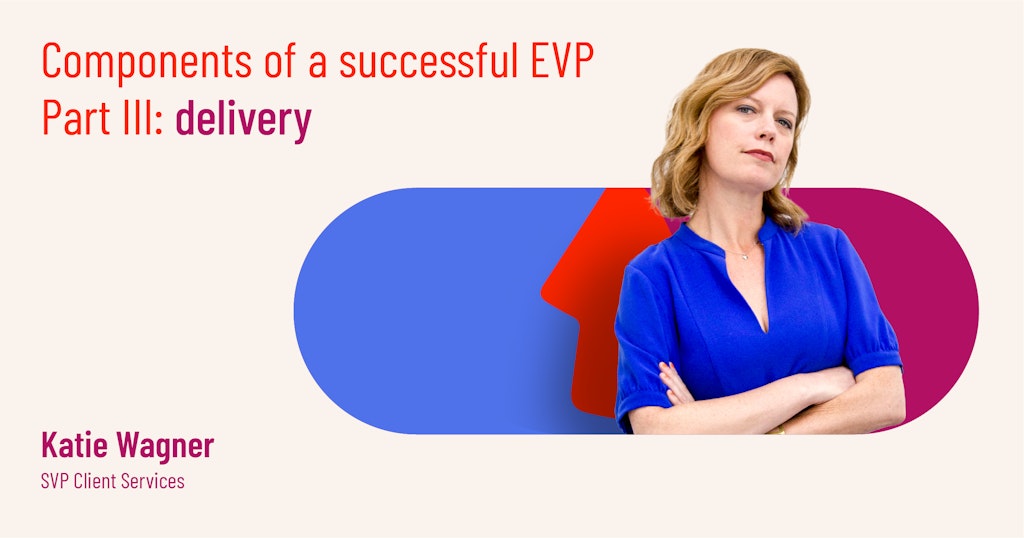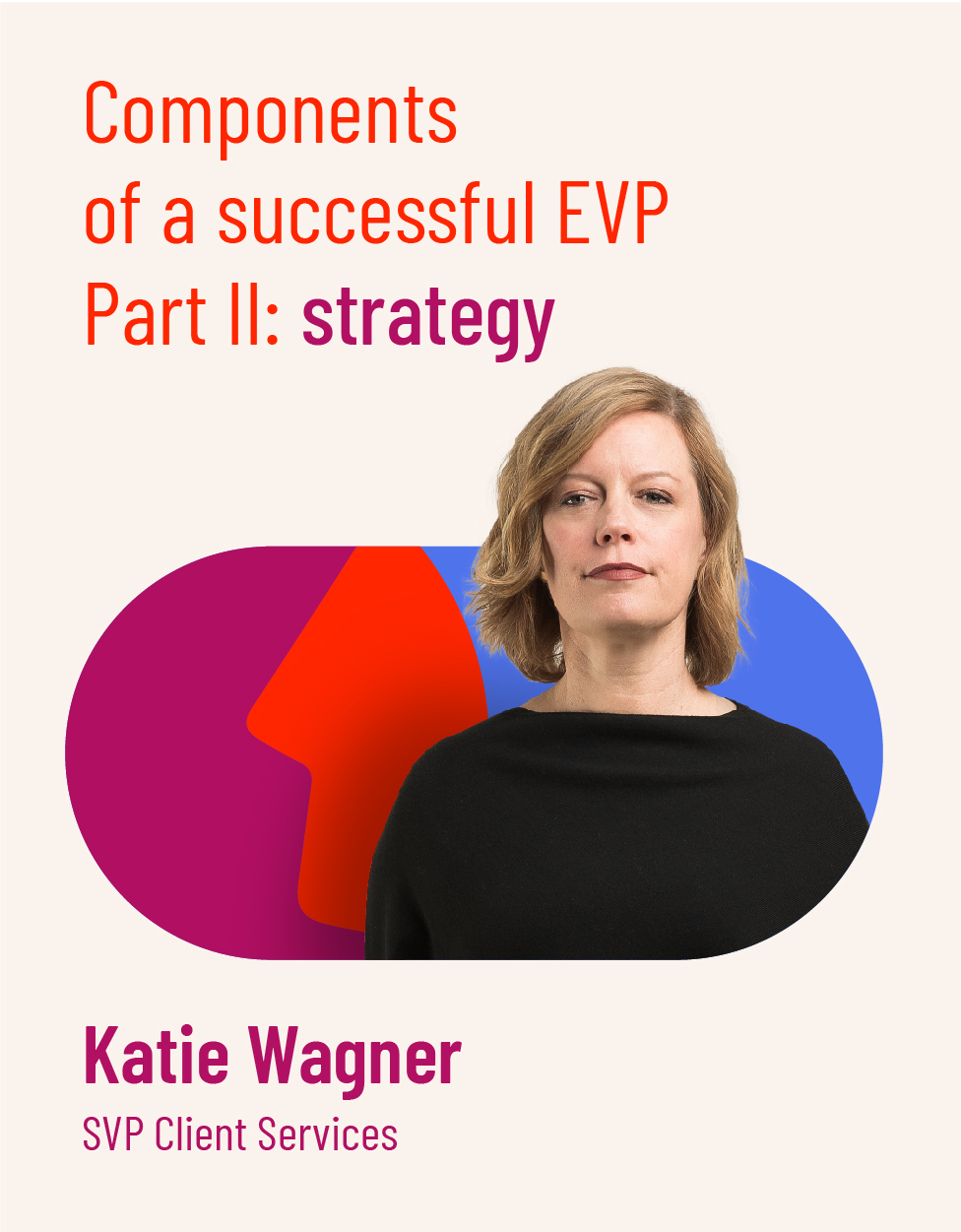Components of a successful EVP—Part III: delivery

To briefly return to the first article of this series—if you don’t tell your employee value proposition (EVP) to your current and future employees, someone else will.
And regarding employee value propositions, they’re only as good or impactful in communicating the promised value of working for your organization as they’re effectively disseminated to employees and candidates.
If employees can’t communicate what the value of working at an organization is, then they aren’t experiencing it. Worse, your messaging goes unguided—that value becoming misrepresented and employees’ understanding of it losing alignment with brand strategy and authenticity.
So, it’s essential that organizations purposefully bring their EVP to life via communications—in every individual message across all channels and experiences for employee and candidate audiences. The bottom line is that EVP activation isn’t a one-off campaign; it’s a continuous endeavor involving creative expressions and strategically informed messaging to embed your EVP throughout the employee journey.
EVP messaging and the importance of narrative
While an EVP strategic framework provides a living document that helps ensure communications, decisions and investments deliver the value promised to employees and candidates for working at an organization, it’s not employee-facing outside of specific roles. And as a result, the strategic framework isn’t something that employees can connect with or use as the foundation of their relationship with an organization.
While your EVP strategic framework provides guidance, you must still create the employee- and candidate-facing communications and messaging that express, reinforce and deliver on your EVP.
That starts with transforming the strategic framework and its summarizing strategy statement into an EVP story and main creative line, respectively.
Your EVP story should be an inspiring and relatable narrative that provides employees and candidates with an emotional manifesto to unite them. It expresses with human and emotive language what it means to work for your organization and the value you receive in exchange. It helps shape the relationships employees and candidates form with your organization and serves as the cornerstone for all EVP storytelling.
Your main EVP creative line distills your strategy statement into a short, universally understood and felt expression that resonates with employees regardless of who they are or where they work in the organization—and, most especially, employee believers. And, just as the strategy statement expands into the five pillars (i.e., the categories tangibly demonstrating an organization’s follow-through on delivering its EVP) of the framework, your main EVP creative line should expand into different iterations that inform pillar-related communications.
The story (generally) and creative line (more overtly) must be woven throughout all communications in such a way that the communications reflect or reinforce employees’ and candidates’ understanding of the EVP.
Communicating your EVP
After creating your EVP and (re)defining the value of working for your organization, you need to ensure that value is continuously and consistently communicated. The strategic framework that informs messaging when expressing your EVP must be embedded in all employee and candidate engagements and touchpoints that those audiences experience throughout their journey and relationship with your company.
Launching an EVP activation campaign focused on amplifying the value of working at the organization will create an overarching storyline until new messages have been incorporated within other communication efforts that are specific to certain EVP pillars—most importantly, for guiding new and existing (or “always-on”) messaging.
Creating new communications
Launching new communications is fairly straightforward, and generally follows four steps before the messages go live:
- Identify your audience and their needs: Your communications should always target your employee brand believers as their primary audience. Still, the communications need to be segmented and tailored according to the specific groups of employees and candidates you’re speaking to. This involves using different elements of the main creative line and support points according to:
- Roles
- Business units
- Locations (particularly for international organizations)
- Additional audience attributes and motivations (e.g., congratulating new parents and offering support when providing information regarding parental leave, emphasizing work flexibility for candidates seeking remote options)
- Match your communication objectives to the audience’s needs: Next, determine which support points and associated expressions are most relevant to the message. For example, information about your employee health insurance plan should draw from and reflect the main strategy statement and creative line as well as those associated with the rewards pillar from your EVP strategic framework.
- Combine messages with your EVP creative line: Prioritize the EVP creative line that best resonates with your target audience according to their need. Double-check to ensure your new campaign’s messaging aligns with your strategic framework and creative expression guidance.
- Pair the message with audience-specific proofs: EVPs are successful when employees and candidates tangibly experience and feel the value promised for working at an organization. And the “proofs” within your EVP strategic framework represent the concrete employee experience decisions and investments made to deliver that promised value. So, your messaging should reference those proofs to demonstrate your brand’s authenticity and follow-through—that you’re more than just talk.
Integrating your EVP with existing or “always-on” communications
It’s more challenging to integrate your EVP with existing communications than to use it for guiding new ones. Some communications and resources (e.g., intranet, employee policy explanations) will already be live and must be relaunched with new creative expressions that better impart the EVP. This involves:
- Identify the context and audience:
- Is the communication:
- Business-focused (e.g., business strategy and transformations, crisis communications)
- Market-focused (e.g., corporate storytelling, innovation, competition)
- People-focused (e.g., total rewards, development opportunities, community outreach)
- Is the communication:
- Determine the goal of the communication: With every communication, there’s an element or iteration of the EVP to impart and reinforce. For example, business strategy and transformation communications should foster resilience and instill confidence in the organization’s future, while total rewards communications should make employees and candidates feel valued for their work.
- Consider which EVP creative messaging to use: Refer to the EVP strategic framework and creative expressions to see which messages should be incorporated into the communication’s revision.
Measuring your EVP-based messaging success
As you launch new communications and revise existing ones according to your EVP strategy and messaging, you’ll also want to measure their impact. Nine to 12 months after you release these communications, you’ll need to conduct assessments to measure results, such as employee relationship tracking (e.g., passion for the brand, willingness to advocate for the organization as an employer) or measuring external perceptions (e.g., third-party reviews, popular sentiment).
Tracking EVP messaging success is cyclical:
- First, you need to launch new communications and revise existing ones.
- Next, measure their performance.
- Finally, analyze those findings to determine whether the messaging was successful, what your most visible channels are, if new proofs are needed or if other actions inspired by the strategic framework are warranted.
Getting your story out to employees and candidates
Not every organization has a problem where glaring gaps between promised value and delivered value expose a lack of authenticity, harm recruitment or jeopardize employee retention. Instead, many organizations actually have a communications and channel problem, where their EVP and dedicated effort to deliver on it aren’t presented to employees and candidates enough or properly. Often, those audiences simply don’t know the incredible value that organizations promise to its employees.
Share your value rather than leaving it up to others to communicate, and embed your EVP throughout every communication and touchpoint with strategy-backed creative expressions to bring it to life.


